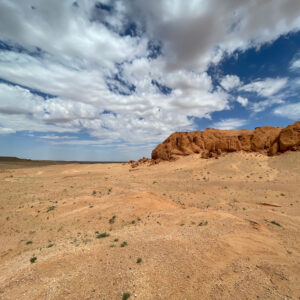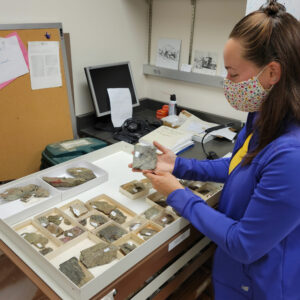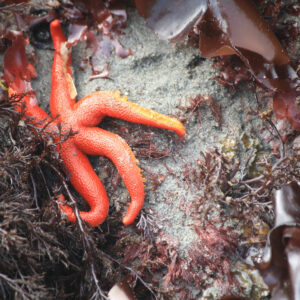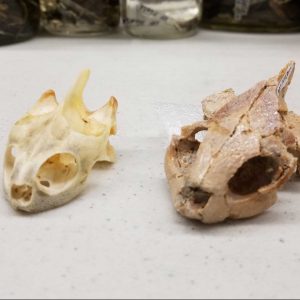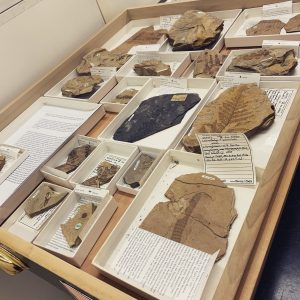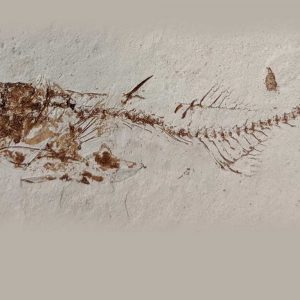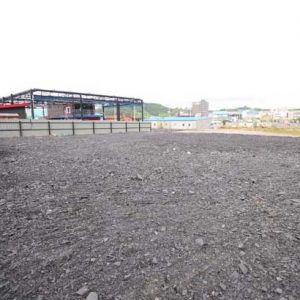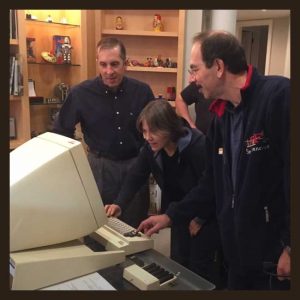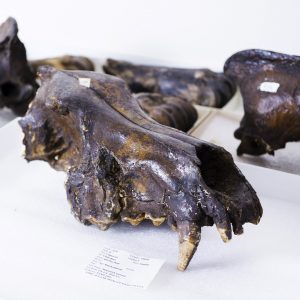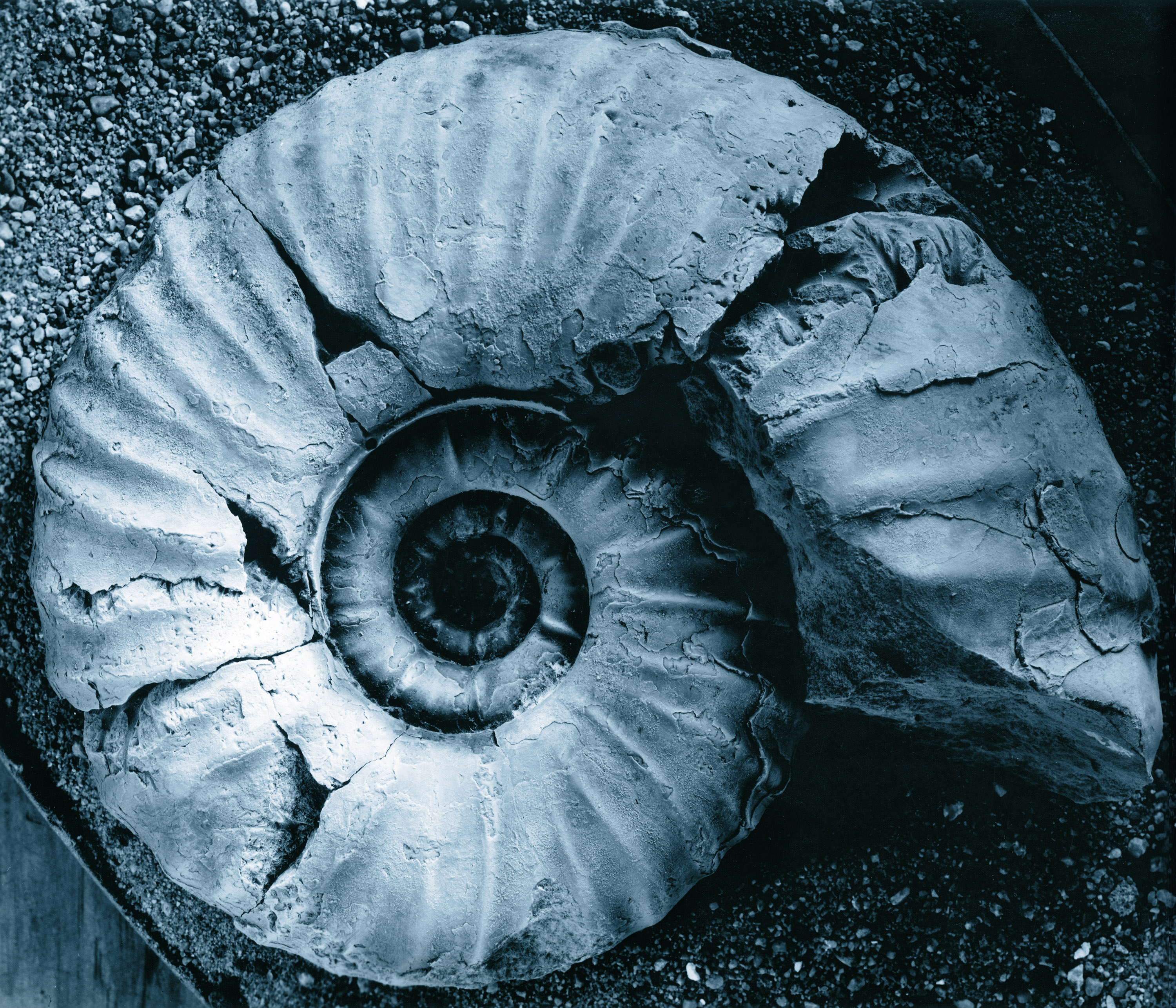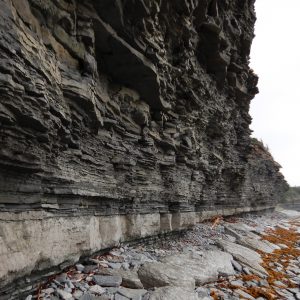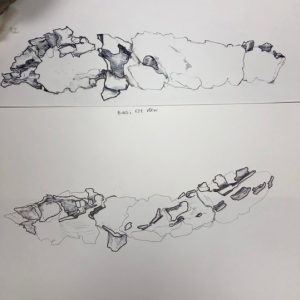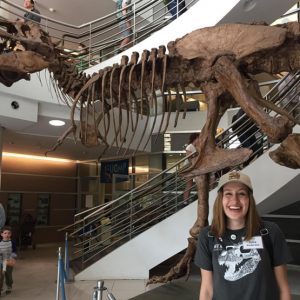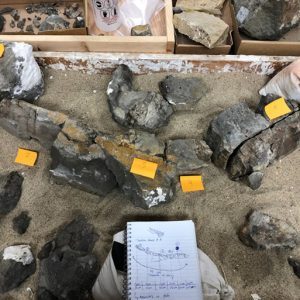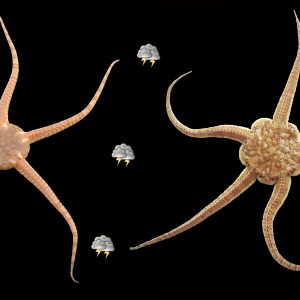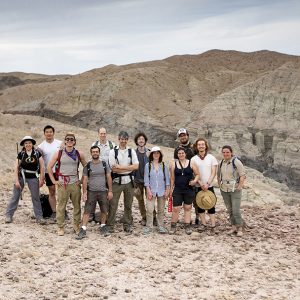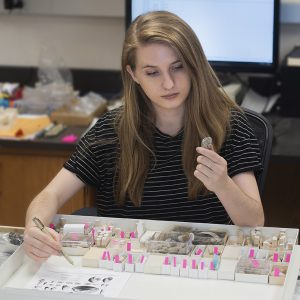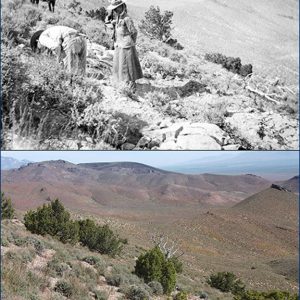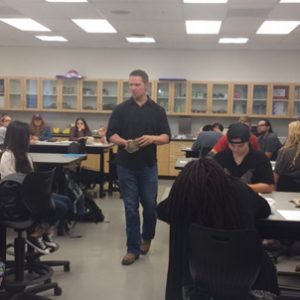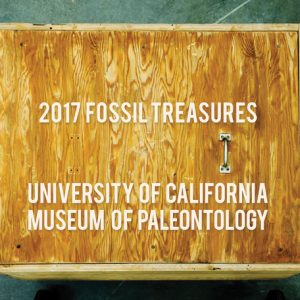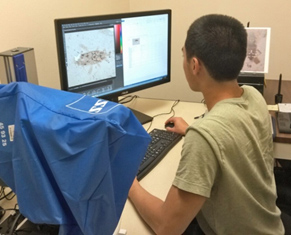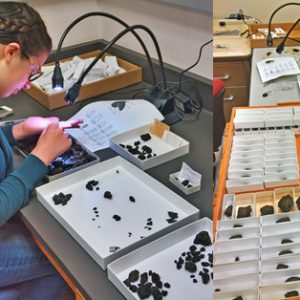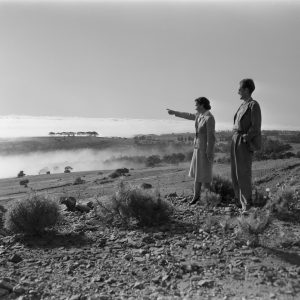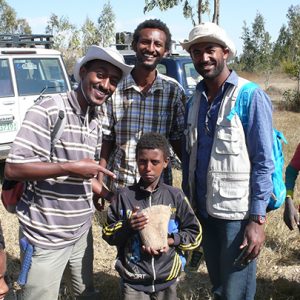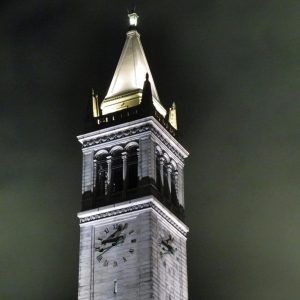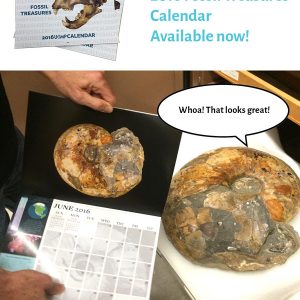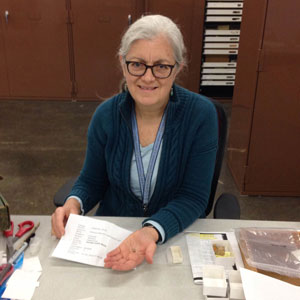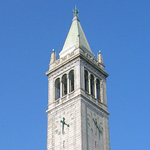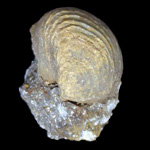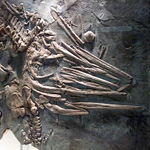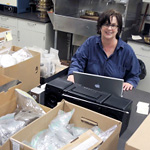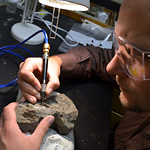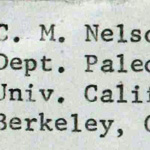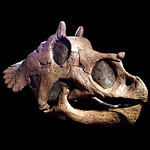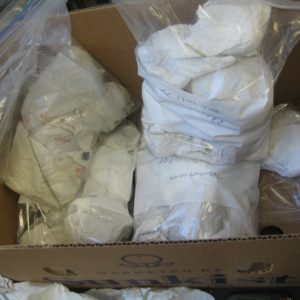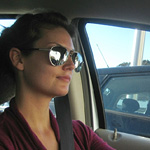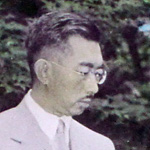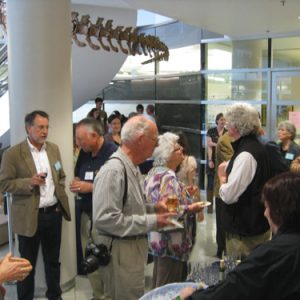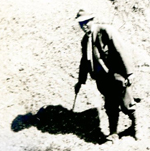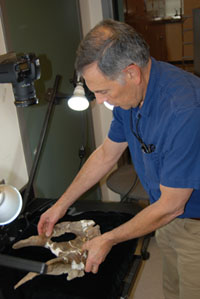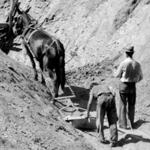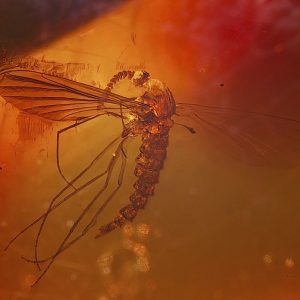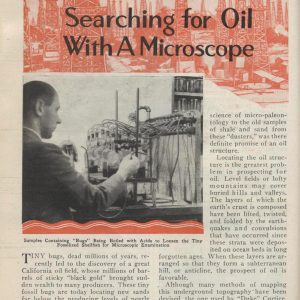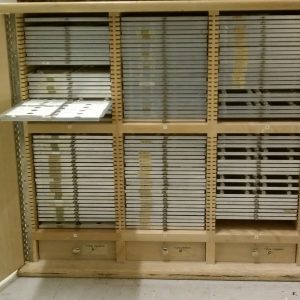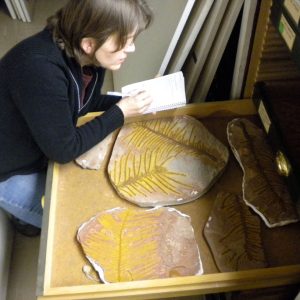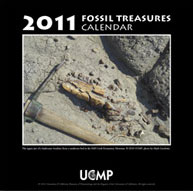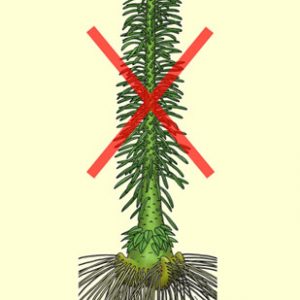THUNK. CA-CHUNK. THUD-THUD-THUD. Our Toyota sedan was not built for the desert. We had blown a tire, out on the remote highway from the Mongolian capital of Ulaanbaatar to the small city of Dalanzadgad, a six hour drive from north to south through the Gobi Desert. The three of us were a team of Filipino, American, and Mongolian educators and paleontologists, heading to the Gobi to lead the summer teacher education program and student summer camp in paleontology. The pitted and … [Read more...] about Cross-Cultural Connections in Paleontology
Forgotten Fossils
Greeting you at the entrance of the University of California Museum of Paleontology (UCMP) is the ever-charismatic Nation’s T. rex, immediately grabbing your attention and drawing you in. Within the UCMP collections area your eyes dart to extinct marine reptiles lining the walls, plant fossils in the aisles with leaves larger than your torso, and woolly mammoth skulls tucked between cabinets. As a vertebrate paleontologist I’m captivated by these grand fossils, making it easy to overlook the … [Read more...] about Forgotten Fossils
Forty phyla in forty days
Marine invertebrate zoology in Friday Harbor, Washington Paleontologists speak of Friday Harbor Labs in the nostalgic tones reserved for only the best field stations. As I hopped off my ferry to the San Juan Islands, carried my duffel bag through the namesake harbor town, and stepped at last under the campus’ old-growth cedars, it was clear why. I came to take FHL’s flagship summer course, Marine Invertebrate Zoology, which surveys forty phyla in as many days. In the mornings, we … [Read more...] about Forty phyla in forty days
The tortoise and the hare: the varied pace of research
Confinement at home due to the Covid-19 pandemic has provided an opportunity to reflect on the pace of my research over the last year. Thinking back to Aesop’s fable of the Tortoise and the Hare, I see that my research has adopted traits from both animals: sometimes moving slow and steady, while other times travelling at break-neck speed. Despite this variability in research pace, the UCMP has been a constant presence during my research through its supportive staff and generous financial … [Read more...] about The tortoise and the hare: the varied pace of research
Back to the Devonian for the Pteridophyte Collection Consortium (PCC) project
During the summer of 2019 we (graduate students Mackenzie Kirchner-Smith and Ixchel Gonzalez-Ramirez) spent a month working in the Paleobotanical Collections of the National Museum of Natural History (NMNH) in DC as part of the NSF-sponsored Pteridophyte Collection Consortium project (PCC). This project, led by PIs Carl Rothfels, Diane Erwin and Cindy Looy, seeks to digitize more than 1.7 million modern and fossil pteridophyte specimens. During the month at the NMNH we digitized more than 700 … [Read more...] about Back to the Devonian for the Pteridophyte Collection Consortium (PCC) project
Fossil fishing for clues about a prehistoric invasion
The school year has ended, but with the ongoing pandemic pushing most usual summertime activities off the table, my thoughts have been turning to how I spent my last summer: organizing fishing trips to Nevada. These excursions weren’t exactly spent relaxing on a boat in Tahoe reeling in trout. Rather, my companions and I were kneeling in a defunct quarry under the desert sun, prying apart layers of blindingly white rock in search of the fossils of small fish that once lived in a long-disappeared … [Read more...] about Fossil fishing for clues about a prehistoric invasion
South Korea’s rich Cretaceous history: A window into the past
Unique and rare deposits in South Korea provide a glimpse of Cretaceous flowering plant ecosystems It has been over a month since the closure of the UC Berkeley campus and the UCMP due to the ongoing pandemic. During the shelter-in-place, I have been fortunate enough to be able to continue research from home. Many images of fossils that I am working on at the moment are from a summer 2019 research trip to South Korea. Thanks to the research award I received from UCMP, I was able to do fieldwork … [Read more...] about South Korea’s rich Cretaceous history: A window into the past
Paleontologic Data Fossilized on IBM 8” Floppies
The Pennsylvanian (323-299 million years ago) is one of the most interesting time periods in Earth’s history. Giant dragonfly relatives like Meganeura (>2 ft wingspan!), 8-ft-long millipedes named Arthropleura, and early mammal-like reptiles lived in a world that likely had atmospheric oxygen levels well above today’s. These animals roamed a landscape dominated by extensive peat swamps, covering large parts of what was then Euramerica. These swamp forests would look entirely … [Read more...] about Paleontologic Data Fossilized on IBM 8” Floppies
Fossil Feature: Multituberculates
The UCMP has one of the best collections of multituberculates, a small mammal from the Cretaceous characterized by their very interesting and very bumpy teeth. Luke Weaver, a PhD candidate from the Wilson Lab at the University of Washington visited the museum in Summer of 2018 to check out the collection and further his own research into these interesting creatures. His visit was supported in part by the Doris O. and Samuel P. Welles Research Fund. Check out the video for more on these … [Read more...] about Fossil Feature: Multituberculates
Are There Dinosaur Bones in UC Berkeley’s Campanile?
KQED's Bay Curious asks: are there dinosaur bones in UC Berkeley's Campanile? UCMP's Pat Holroyd and Leslea Hlusko answer this question. … [Read more...] about Are There Dinosaur Bones in UC Berkeley’s Campanile?
25 years of the UCMP website
Forgive us. We nearly didn’t notice until late 2018 that the year marked the 25th anniversary of the UCMP website! We decided that early 2019 was a good time to celebrate that milestone since the site is undergoing a somewhat radical redesign, only the fourth big design change in its history. We felt that this was also a good time to look back at those 25 years and pick out some of the highlights. I contacted website founders Rob Guralnick, currently Associate Curator of Biodiversity … [Read more...] about 25 years of the UCMP website
Reading between the rocks: Reinterpreting the Late Ordovician mass extinction
This past summer, I had the opportunity to conduct my first field season on Anticosti Island (Québec, Canada). Located in the subarctic of Canada, Anticosti Island preserves a 200 kilometer-long transect of ancient seafloor. Late Ordovician tropical reefs and fossils are beautifully preserved across the island in towering coastal cliffs and river canyons. The sheer size of the island is astounding, and the insight its fossil record could provide into early Paleozoic marine communities is … [Read more...] about Reading between the rocks: Reinterpreting the Late Ordovician mass extinction
Science and the arts are not incompatible
Working in a paleontology prep lab as an Anthropology major who leans towards cultural analysis was something that seemed out of left field for me. I was sitting in the corner of a lab that was strewn with rocks and fossils that I didn’t know yet were fossils for my job interview, and I was asked to give more detail on my experience in art. I didn’t really expect it to be something that would be so important to my job here at the Museum of Paleontology, but my experience outside of the “hard … [Read more...] about Science and the arts are not incompatible
Working in the UCMP fossil prep lab
Throughout my whole life I have known that I would make my passion my career someday. However, the road to success in vertebrate paleontology can be a rocky one (no pun intended), sometimes without direction or opportunity. Fortunately, the University of California Museum of Paleontology seeks to help aspiring scientists, such as myself, obtain hands-on experience in the field of paleontology! My name is Julia Anderson, and I am a senior undergraduate student, actively seeking my place amongst … [Read more...] about Working in the UCMP fossil prep lab
The Tale of Sandbox Whale
One of the exciting projects we worked on in the prep lab was the assembly of the remains of a whale skull, known as "Sandbox Whale". The project, from its plaster jacket beginnings to the finished product, relied on various skills that we have learned in the prep lab. I find that most of our projects, like the Sandbox Whale, require creativity and patience. The opening of the rigid plaster jacket required the use of wet rags to loosen the jacket so we could rip it open. This is a clever … [Read more...] about The Tale of Sandbox Whale
How often does extreme competition occur between species on the ocean floor?
Look around in nature or even in the city and you will see that organisms are not static entities, but interact with one another. Think of a robin with a worm in its beak, a tick crawling on your leg looking for a spot to puncture your skin, or two bucks fighting during the rutting season for the right to mate. The sea floor is also a place where animals search or fight for food to stay alive. On the continents, food is not unlimited; every individual tries to collect a piece of the pie (Fig. … [Read more...] about How often does extreme competition occur between species on the ocean floor?
2018 Spring Break Field Trip
Four states, nine days, 2,850 miles, 48 hours cumulative driving and enumerable sponges. The Field Methods in Paleobiology Course, also known as the 2018 Spring Break Field Trip, from March 24, 2018 to April 1, 2018, was a whirlwind tour of the Southwest with IB Faculty/UCMP Curators Cindy Looy, Ivo Duijnstee and Seth Finnegan leading a group of students, a professor on sabbatical and one staff member to West Texas to the explore the ancient Capitan Reef formation in and around Guadalupe … [Read more...] about 2018 Spring Break Field Trip
UCMP now has over 100,000 cataloged invertebrate specimens
Thanks to our recent digitization projects, UCMP now has topped 100,000 cataloged invertebrate specimens! At least 6500 of these are fossil insects, millipedes and spiders digitized by Dr. Diane Erwin and undergraduate students under Berkeley's Fossil Insect PEN. Helping make all this possible was the work by the following participants: Dr. Marwa Wafeeq Abdelkhaliq Ibraheem (Ain Shams University, Egypt; volunteer), graduate students Winnie Hsiung and Rosemary Romero, as well as undergraduate … [Read more...] about UCMP now has over 100,000 cataloged invertebrate specimens
Russell Waines’ stromatoporoid collection
Russell H. Waines was a geologist who dedicated most of his life to ancient sponges, the stromatoporoids, which were one of the most important reef builders during the Paleozoic. When I was a graduate student researcher at the UCMP in 2013, I had the pleasure of organizing this collection (Figure 1), which includes approximately 2000 fossil specimens (566 of which are registered in the UCMP database) mainly from the Devonian of Nevada, but also from Alaska, Arizona, California, New York, Utah, … [Read more...] about Russell Waines’ stromatoporoid collection
Exploring Annie Alexander’s Saurian Expedition of 1905
In 1905 UCMP benefactress Annie Alexander financed and took part in an expedition to the West Humboldt Mountains of Nevada to collect vertebrate fossils in the Triassic limestones. The crew came home with portions of some 25 ichthyosaur skeletons. Alexander put together a scrapbook containing her chronicle of the trip and many photographs; the scrapbook was given to UCMP following Alexander’s death in 1950 and is one of the most treasured items in the museum’s archives. Up until now, the … [Read more...] about Exploring Annie Alexander’s Saurian Expedition of 1905
Guest lecturing at Los Medanos Community College
Roughly 10 million students attend American community colleges each academic year, accounting for more than a third of all American undergraduates. Relative to their peers at four-year institutions, community college students are much more likely to come from lower income households, much more likely to be members of an underrepresented minority group, and much more likely to be a first-generation college student. I was lucky enough to spend three years as a faculty member of a Denver-area … [Read more...] about Guest lecturing at Los Medanos Community College
2017 Fossil Treasures Calendar Available Now!
Revealing the collections at Regatta The 2017 Fossil Treasures Calendar is a bit of a 'behind-the-scenes' look at the work done at UCMP and celebrates some impressive fossil specimens we hold at the Regatta Facility in Richmond, CA. We have both fossils large in size and large in number and featured in this calendar are the large antlers from the giant elk, hundreds of vials of microfossils and even dinosaur fossils formerly on display at Cal Academy, namely the legs of the Allosaurus. So get … [Read more...] about 2017 Fossil Treasures Calendar Available Now!
Hiep Nguyen’s UCMP undergraduate research experience: “Scentless in Nevada”
This past year, I’ve been working with UCMP Senior Museum Scientist Diane M. Erwin to identify a new fossil species of scentless plant bug (family Rhopalidae) from a Miocene lakebed deposit in Stewart Valley, Nevada. The study developed as a result of my participation as an Undergraduate Research Apprentice (URAP) in UC Berkeley’s Fossil Insect Digitization PEN project (BFIP) funded by the National Science Foundation. The BFIP project is part of the Fossil Insect Collaborative Thematic … [Read more...] about Hiep Nguyen’s UCMP undergraduate research experience: “Scentless in Nevada”
Meschelle Thatcher’s UCMP undergraduate research experience: Beetles in Brea!
As an English major, I didn’t really know what to expect when I first started my URAP (Undergraduate Research Apprenticeship Program) appointment for the UC Museum of Paleontology Fossil Insect PEN (Partner to an Existing Network) funded by the National Science Foundation. All I knew was that I’d be handling fossils, and that struck the scientific chord in my imagination in perfect harmony. The Pleistocene Rancho La Brea tar pits in southern California are best known for their extinct exotic … [Read more...] about Meschelle Thatcher’s UCMP undergraduate research experience: Beetles in Brea!
Our journey from the UCMP to South Africa to study fossil monkeys
At the time we got involved in what has now become for us - the South Africa project - one of us (Tesla) was soon-to-be a second year graduate student, and the other (Marianne) was about to start her senior year as an undergraduate student here at UC Berkeley. We began working together in the UC Museum of Paleontology (UCMP) during the summer of 2013, making our way through a massive project and cataloguing exceptional fossil material collected during the UC Africa Expedition of 1947 and 1948. … [Read more...] about Our journey from the UCMP to South Africa to study fossil monkeys
A first: Sauropod bones found in Ethiopia!
Assistant Director Mark Goodwin and his project collaborators (see Feb. 1 blog post) made a surprising discovery while collecting microvertebrates, turtles, and fish. Within a small area of exposure in the Late Jurassic Agula Shale in the Tigray Province, just south of Mekele, Ethiopia, were the first sauropod dinosaurs ever reported from Ethiopia! The team found mostly partial bones and bone fragments, and the local school kids delighted in holding Ethiopia's first sauropod dinosaur bones. … [Read more...] about A first: Sauropod bones found in Ethiopia!
Bones in the Belltower, a Berkeley Science Review feature by Sara ElShafie
The Fall 2015 issue of the Berkeley Science Review features an article by Sara ElShafie, a UCMP graduate student in the Padian Lab, on the McKittrick tar seep fossils that have been stored in the Campanile since the 1930s. The convergence of an Institute of Museum and Library Services grant to the UCMP to clean and catalogue more the 12,000 specimens in the collection and the centennial celebration of the Campanile in 2015 shined a spotlight on these unique fossils. In interviews with UCMP … [Read more...] about Bones in the Belltower, a Berkeley Science Review feature by Sara ElShafie
The 2016 Fossil Treasures Calendar is now available at UCMP
Sharing the Collections at UCMP The new year's calendar focuses on the collections and the unique specimens that can be found here. UCMP is a research museum, which means that access is limited to researchers, our students, and affiliates. The 2016 calendar allows us to bring the collections to our supporters and the general public. Grants from the National Science Foundation and the Institute of Museum and Library Sciences enabled us to restore, catalog and digitize new specimens more rapidly … [Read more...] about The 2016 Fossil Treasures Calendar is now available at UCMP
UCMP volunteers discover important specimen
UCMP volunteers Kathy Zoehfeld and Don Pecko recently discovered a type specimen from the Smithsonian National Museum of Natural History among the hundreds of thousands of fossils in the former USGS Menlo Park collection. This type specimen, a tiny gastropod called Ceratia nixilia, was discovered in a drawer of fossils they were rehousing into new archival boxes. Don and Kathy not only noticed the less than a centimeter long gastropod, but brought it to my attention because they noticed the … [Read more...] about UCMP volunteers discover important specimen
Fossils in the Campanile? It’s true!
If you have taken the elevator to the top of Sather Tower, aka the Campanile, perhaps you've heard that some of the floors of the tower are filled with fossils. This is not a campus myth, it's fact! The Campanile is celebrating its 100th anniversary this year and its very first occupants — moving in before the tower was even completed — were fossils. At that time, the museum and Department of Paleontology were in Bacon Hall, just east of the Campanile, so as a storage facility, the … [Read more...] about Fossils in the Campanile? It’s true!
Encounters in the field: UCMP and the US Geological Survey
Hundreds of specimens from the former USGS Menlo Park Collection, now housed in the UC Museum of Paleontology, were collected in the pioneering days of geological and paleontological exploration of California. This includes fossils collected by Charles A. White, Timothy W. Stanton, Joseph S. Diller and other legendary figures at the US Geological Survey. The newly founded Department of Paleontology at UC Berkeley also led numerous expeditions and excavations of vertebrates in California in the … [Read more...] about Encounters in the field: UCMP and the US Geological Survey
Cataloging the archives: Paleontology specimen exchange
How do natural history museums build their collections? The UCMP's fossil collection is largely a product of decades of field work by past and present researchers. As the State's fossil repository, the museum also receives a large number of fossil finds from construction sites in California (for example, the Caldecott Tunnel). Another, perhaps less appreciated means of acquiring scientifically valuable specimens, is specimen exchange between institutions — it's a bit like a holiday gift exchange … [Read more...] about Cataloging the archives: Paleontology specimen exchange
Finding forams in the Caldecott Tunnel
Day after day, over the course of two years, the massive tunnel borer worked its way through the sedimentary rock layers of the Berkeley Hills during the construction of the fourth bore of the Caldecott Tunnel, grinding up the rocks in the process into fist-size pieces that were later deposited outside the entrance of the tunnel. At the end of each work day, paleontologists sifted through these piles, referred to as the day’s "spoils." They were not only on the lookout for fossils of plants and … [Read more...] about Finding forams in the Caldecott Tunnel
Prepping the fossils from the Caldecott Tunnel
For the last semester I have been lucky enough to work as the GSR (graduate student researcher) for the spring semester at the UC Museum of Paleontology fossil preparation lab (prep lab) under the supervision of our new lab manager, Jason Carr. It has been fun getting back into the preparation role, something that I did as a job after college. The material we have to work on varies a lot which keeps the work interesting. It requires a variety of techniques, so I get to do something different … [Read more...] about Prepping the fossils from the Caldecott Tunnel
Reports from Regatta: Two Cal Alumni and the USGS Menlo Park Collection
As undergraduate work-study students recataloging the United States Geological Survery (USGS) Menlo Park Invertebrate collection at the UCMP, we've come across the names Nelson and Addicott time and time again in extensive database entries or on the original, yellowing locality cards paired with each specimen. The names of the paleontologists and geologists responsible for collecting these fossils in the Menlo Park collection are largely unknown to us, but found immersed within the aging drawers … [Read more...] about Reports from Regatta: Two Cal Alumni and the USGS Menlo Park Collection
Cataloging the Archives: Three Fine Trikes
Another in a series of blog posts relating to the museum's "cataloging the archives" project Ask children what their favorite dinosaurs are, and it's almost guaranteed that Triceratops (refer to them by their nickname, Trikes, and you'll earn tons of street cred) will be on the list. The three-horned, frilled wonder is one of the most recognizable creatures of the Cretaceous. Many a visitor has walked by the Triceratops display here in the Valley Life Sciences Building's Marian Koshland … [Read more...] about Cataloging the Archives: Three Fine Trikes
The Arrival of the Fossils
The UCMP houses one of the largest fossil collections associated with a university in the world, so it is no wonder that some of the fossils need to be stored off-campus at the UC Regatta facility, located nearby in Richmond. This large warehouse is home to multiple campus-wide museum collections, including a variety of enormous whale skulls, huge ichthyosaur skeletons, and cyclopean bones of mammoths and dinosaurs from the Museum of Paleontology. The Regatta facility is also the current … [Read more...] about The Arrival of the Fossils
Fossil neighbors
About once a month, I drive from Berkeley to Walnut Creek to pick up specimens for my thesis (dead birds for a study of the evolution of development in Aves), which necessitates a pass through the Caldecott Tunnel. Each time, I heave a sigh and try to shore up my patience as traffic before the tunnels slows to a stop. However, this bane has recently metamorphosed into an object of great interest, for it has come to my attention that the construction here is also uncovering of one of Earth’s most … [Read more...] about Fossil neighbors
Cataloging the archives: Chaney, the Emperor and Metasequoia
Another in a series of blog posts relating to the museum's "cataloging the archives" project The UCMP archives contain five large scrapbooks containing museum-related newspaper clippings dating from 1948 to 1989. The earliest clippings in the oldest scrapbook concern UCMP paleobotanist Ralph Chaney's 1948 trip to central China to see for himself, Metasequoia, a tree thought to have been extinct since the Miocene. The existence of this living fossil had just been publicized in a paper by Hu and … [Read more...] about Cataloging the archives: Chaney, the Emperor and Metasequoia
A special night at UCMP
Cal Day is the one day of the year when lucky members of the public can tour UCMP's collection. But this year, on the night before Cal Day, UCMP hosted a special event to take some of our closest friends behind the scenes. This invitation-only event included sneak previews of Cal Day exhibits, tours of the collection, the paleo art of William Gordan Huff, and fossils recovered during the construction of the Caldecott Tunnel's fourth bore. UCMP-affiliated faculty curators, scientists, … [Read more...] about A special night at UCMP
Cataloging the archives: Geology camp 100 years ago
Looking at UCMP's modern offices and collections space, one might not appreciate that the paleontology tradition at Berkeley stretches back more than one hundred years. But now the CLIR/UCMP Archive Project is bringing this history to light. Some of the oldest supplemental locality files I have come across this semester contain class reports and geologic maps prepared by a Cal field geology class in the summer of 1911. Led by Bruce L. Clark, who eventually became the first director of the … [Read more...] about Cataloging the archives: Geology camp 100 years ago
Photo shoots for UCMP science
This semester, the UCMP has been excited to host a visiting photographer, UC alum Dave Strauss. A self-described "computer guy" for the last 42 years, he is also an avid naturalist, hiker, and mountain biker. Dave finds inspiration at the UCMP through the opportunity to use his talents to communicate evolutionary and historical knowledge to the broader community. Collaboration with Dave has provided many opportunities to contribute to science. He has confronted technical challenges … [Read more...] about Photo shoots for UCMP science
Cataloging the archives: Unearthing a type
This semester, one of the foci of the CLIR/UCMP Archive Project has been cataloging what are called “supplemental locality files.” These files contain materials (other than field notes) that are relevant to UCMP collections, such as polaroid pictures of fossil sites, letters of correspondence involving UCMP scientists, and environmental impact reports for land development proposed in areas with known fossil sites. As such, they are unique records of how collections came to be, and how … [Read more...] about Cataloging the archives: Unearthing a type
The Amber Files: Words from the University Explorer
"More than 300 years ago, Sir Francis Bacon spoke of amber as 'a more than royal tomb' for tiny insects. Twentieth century scientists may quite agree." But how do insects end up as amber fossils? What else is found in amber? How are these amber fossils prepared for study? The answers to these questions can be found in one of the hidden collections of UCMP's archives — the 1561st broadcast of "The University Explorer." This show was narrated by Hale Sparks, former head of broadcasting … [Read more...] about The Amber Files: Words from the University Explorer
Relicts of the Bug-men
What are bug-men and how did their existence benefit UCMP? Watch and listen to this slideshow about an obscure link recently discovered by UCMP micropaleontologist Ken Finger. Click cover page below to download the full article. … [Read more...] about Relicts of the Bug-men
The Amber Files
Unbeknownst to some, UCMP is home to a large collection of amber-encased insect specimens. While some of the most famous amber fossils come from the region south of the Baltic Sea, the majority of UCMP’s amber collection hails from the Chiapas region of Mexico, illuminating never before captured environments of the Western Hemisphere. Spanning nearly two decades from the mid-1950s through the 1970s, efforts to collect and study these specimens were spearheaded through collaboration between the … [Read more...] about The Amber Files
“Field Notes”: Devonian liverworts and Permian conifers
On a cold Berkeley morning late in March paleobotanist Cindy Looy and grad student Susan Tremblay hopped on a plane to Washington DC. Their goal was not to enjoy the gorgeous spring weather and peaking cherry blossoms, but instead to search for clues to the early evolution of plants in the collections of the National Museum of Natural History (NMNH). Devonian liverworts and Permian conifers were on the menu. Pallaviciniites devonicus, described by Francis Hueber in 1961, is one of the oldest … [Read more...] about “Field Notes”: Devonian liverworts and Permian conifers
Cal Day 2011 is here!
It's that time of year we've all been waiting for: Cal Day! This Saturday marks the one day a year UCMP opens its doors to the public and plays host to a number of events aimed to expose all those who are interested to the fascinating world of fossils. Stop by the Valley Life Sciences Building for festivities that range from digging for bones to learning about climate change. Found a fossil you need identified? Our experts have set up shop to help you out with just that. Don't forget to … [Read more...] about Cal Day 2011 is here!
National Fossil Day at UCMP
Yesterday was the first ever National Fossil Day and UCMP pulled out all the stops! Come check out the new online exhibit, Fossils in our parklands: Examples of UCMP service and stewardship, featuring fossils in UCMP's collection from national and state parks in California, Nevada, Oregon, and Montana. The museum played a pivotal role in the creation of some of the featured parks and we're happy to highlight our shared histories. Additionally, the 2011 UCMP Fossil Treasures Calendar is now … [Read more...] about National Fossil Day at UCMP
Museum nomads
For many paleobiologists summer is that part of the year during which data is gathered in its purest form: fossils. Such summers may take you in diametrically opposite directions, though. Some bring broadly boasted outdoor adventures of fieldwork. Others, however, take you deeper and deeper into the collection labyrinths in the dark bowls of natural history museums around the globe. Despite what others may let you believe - and don’t tell anyone we told you - fieldwork is often boring, tedious … [Read more...] about Museum nomads
